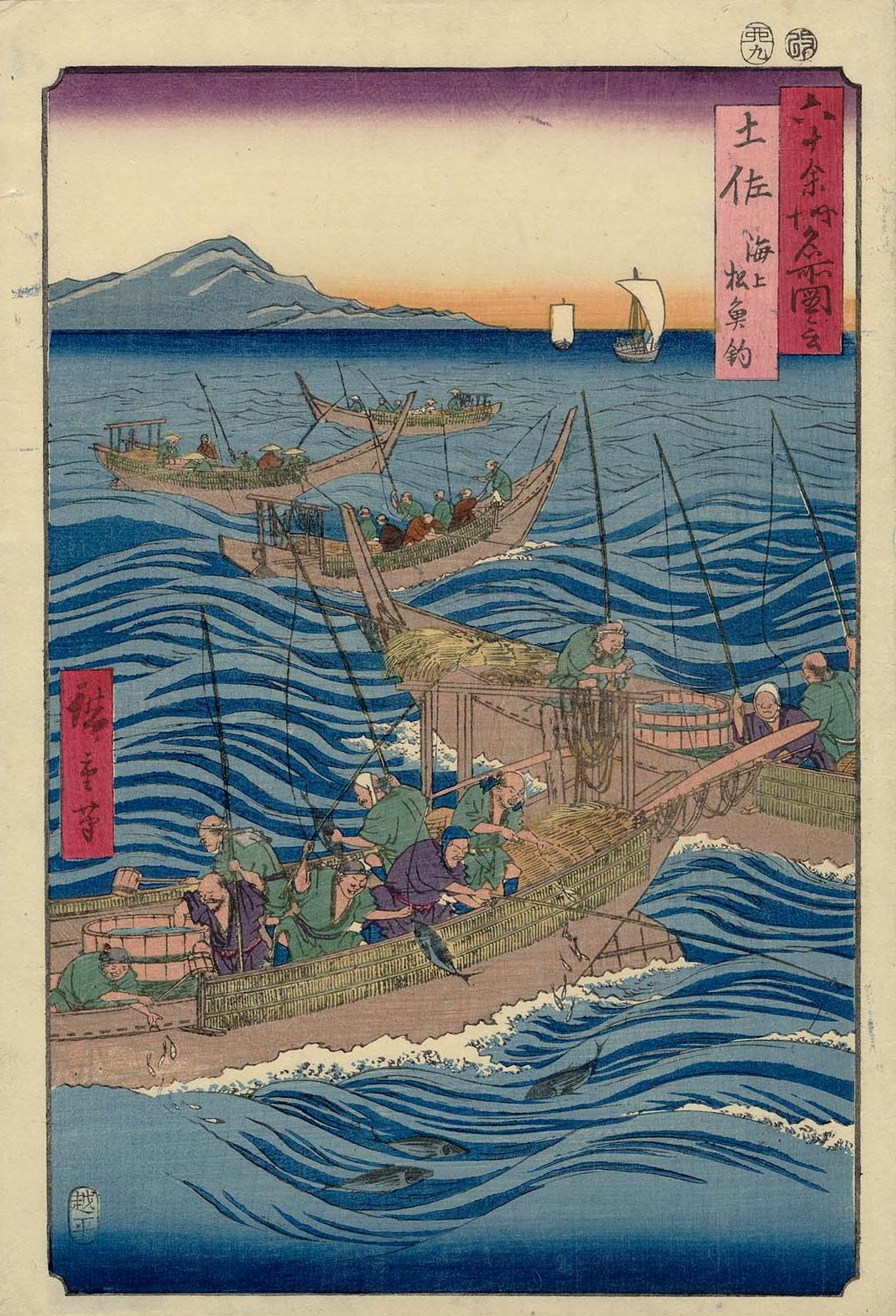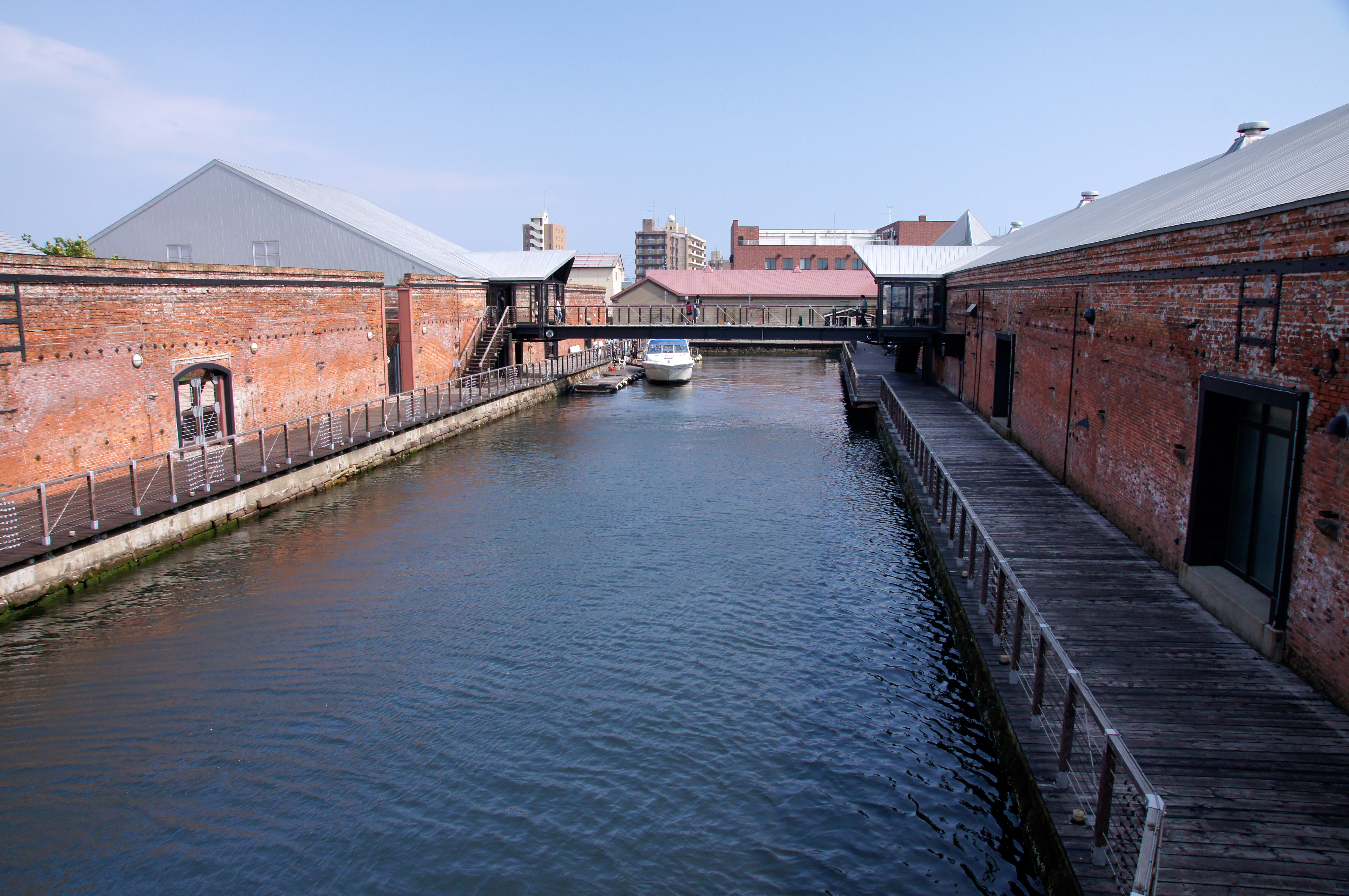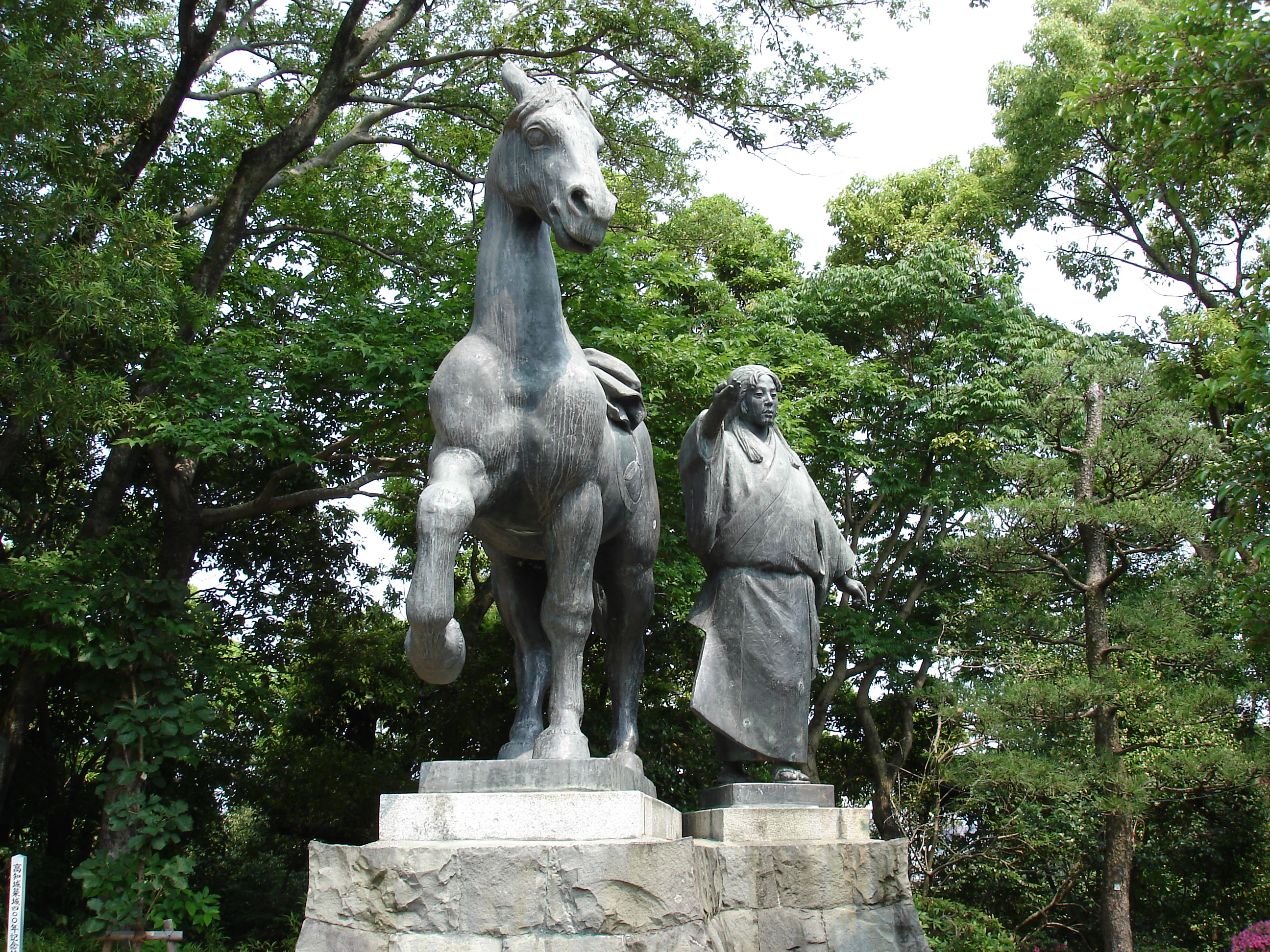|
Aki Castle
was a castle of the Aki clan in what is now the city of Aki, Kōchi Prefecture, Japan. Ruins still remain and the site was designated an Aki City Historic Site. It is believed the castle was built by Aki Chikauji in 1308. In 1569, the castle was besieged by Chōsokabe Motochika's force. Aki Kunitora, who was known as one of the seven great samurai of the Aki, entrenched himself in the castle, but later surrendered and committed seppuku. Following the fall of the castle, Motochika appointed his younger brother Kōsokabe Chikayasu as the lord of the castle and the castle became an important base for the Chōsokabe clan to invade Awa. After the Battle of Sekigahara, Tosa Province was given to Yamanouchi Kazutoyo and he appointed his senior vassal Goto Tameshige as the lord of the castle. The castle is now in ruins, with low some stone walls, wet moats, and ramparts or other earthworks. The Aki City Historical Museum is on site. Adjacent to the castle is the preserved samurai ... [...More Info...] [...Related Items...] OR: [Wikipedia] [Google] [Baidu] |
Aki, Kōchi
270px, Aki City Hall 270px, Aerial view of Aki city center is a city located in Kōchi Prefecture, Japan. , the city had an estimated population of 16,370 in 8076 households and a population density of 52 persons per km². The total area of the city is . Geography Aki is located in southeastern Kōchi Prefecture, facing Tosa Bay of the Pacific Ocean to the south and bordered by mountains to the north. The urban area is on the plains of the Aki River. Neighbouring municipalities Kōchi Prefecture * Kōnan * Kami * Yasuda * Umaji * Geisei Tokushima Prefecture * Naka Climate Aki has a humid subtropical climate (Köppen climate classification ''Cfa'') with hot, humid summers and cool winters. There is significant precipitation throughout the year, especially during June and July. The average annual temperature in Aki is . The average annual rainfall is with June as the wettest month. The temperatures are highest on average in August, at around , and lowest in January, at a ... [...More Info...] [...Related Items...] OR: [Wikipedia] [Google] [Baidu] |
Tosa Province
was a province of Japan in the area of southern Shikoku. Nussbaum, Louis-Frédéric. (2005). "''Tosa''" in . Tosa bordered on Awa to the northeast, and Iyo to the northwest. Its abbreviated form name was . In terms of the Gokishichidō system, Tosa was one of the provinces of the Nankaidō circuit. Under the ''Engishiki'' classification system, Tosa was ranked as one of the "middle countries" (中国) in terms of importance, and one of the "far countries" (遠国) in terms of distance from the capital. The provincial capital was located in what is now the city of Nankoku. The ''ichinomiya'' of the province is the Tosa shrine located in the city of Kōchi. retrieved 2011-08-09 [...More Info...] [...Related Items...] OR: [Wikipedia] [Google] [Baidu] |
Former Castles In Japan
A former is an object, such as a template, gauge or cutting die, which is used to form something such as a boat's hull. Typically, a former gives shape to a structure that may have complex curvature. A former may become an integral part of the finished structure, as in an aircraft fuselage, or it may be removable, being using in the construction process and then discarded or re-used. Aircraft formers Formers are used in the construction of aircraft fuselage, of which a typical fuselage has a series from the nose to the empennage, typically perpendicular to the longitudinal axis of the aircraft. The primary purpose of formers is to establish the shape of the fuselage and reduce the column length of stringers to prevent instability. Formers are typically attached to longerons, which support the skin of the aircraft. The "former-and-longeron" technique (also called stations and stringers) was adopted from boat construction, and was typical of light aircraft built until the ad ... [...More Info...] [...Related Items...] OR: [Wikipedia] [Google] [Baidu] |
Castles In Kōchi Prefecture
A castle is a type of fortified structure built during the Middle Ages predominantly by the nobility or royalty and by military orders. Scholars debate the scope of the word ''castle'', but usually consider it to be the private fortified residence of a lord or noble. This is distinct from a palace, which is not fortified; from a fortress, which was not always a residence for royalty or nobility; from a ''pleasance'' which was a walled-in residence for nobility, but not adequately fortified; and from a fortified settlement, which was a public defence – though there are many similarities among these types of construction. Use of the term has varied over time and has also been applied to structures such as hill forts and 19th-20th century homes built to resemble castles. Over the approximately 900 years when genuine castles were built, they took on a great many forms with many different features, although some, such as curtain walls, arrowslits, and portcullises, were ... [...More Info...] [...Related Items...] OR: [Wikipedia] [Google] [Baidu] |
List Of Historic Sites Of Japan (Kōchi)
This list is of the Historic Sites of Japan located within the Prefecture of Kōchi. National Historic Sites As of 1 July 2019, twelve Sites have been designated as being of national significance. Prefectural Historic Sites As of 1 May 2018, thirty-one Sites have been designated as being of prefectural importance. Municipal Historic Sites As of 1 May 2018, a further three hundred and thirty-five Sites have been designated as being of municipal importance. See also * Cultural Properties of Japan * Tosa Province * List of Cultural Properties of Japan - paintings (Kōchi) * List of Places of Scenic Beauty of Japan (Kōchi) This list is of the Monuments of Japan, Places of Scenic Beauty of Japan located within the Prefectures of Japan, Prefecture of Kōchi Prefecture, Kōchi. National Places of Scenic Beauty As of 1 September 2019, three Places have been Cultural P ... References External links *Cultural Properties in Kōchi Prefecture {{DEFAULTSORT:Hstoric sites ... [...More Info...] [...Related Items...] OR: [Wikipedia] [Google] [Baidu] |
Groups Of Traditional Buildings
is a Japanese category of historic preservation introduced by a 1975 amendment of the law which mandates the protection of groups of traditional buildings which, together with their environment, form a beautiful scene. They can be post towns, castle towns, mining towns, merchant quarters, ports, farming or fishing villages, etc. The Japanese government's Agency for Cultural Affairs recognizes and protects the country's cultural properties under the Law for the Protection of Cultural Properties. Municipalities can designate items of particular importance as and approve measures to protect them. Items of even higher importance are then designated by the central government. The Agency for Cultural Affairs then provides guidance, advice, and funds for repairs and other work. Additional support is given in the form of preferential tax treatment. As of May 31, 2021, 126 districts have been classified as Important Preservation Districts for Groups of Traditional Buildings. List of Imp ... [...More Info...] [...Related Items...] OR: [Wikipedia] [Google] [Baidu] |
Samurai
were the hereditary military nobility and officer caste of medieval and early-modern Japan from the late 12th century until their abolition in 1876. They were the well-paid retainers of the '' daimyo'' (the great feudal landholders). They had high prestige and special privileges such as wearing two swords and ''Kiri-sute gomen'' (right to kill anyone of a lower class in certain situations). They cultivated the '' bushido'' codes of martial virtues, indifference to pain, and unflinching loyalty, engaging in many local battles. Though they had predecessors in earlier military and administrative officers, the samurai truly emerged during the Kamakura shogunate, ruling from 1185 to 1333. They became the ruling political class, with significant power but also significant responsibility. During the 13th century, the samurai proved themselves as adept warriors against the invading Mongols. During the peaceful Edo period (1603 to 1868), they became the stewards and chamberlains of ... [...More Info...] [...Related Items...] OR: [Wikipedia] [Google] [Baidu] |
Rampart (fortification)
In fortification architecture, a bank or rampart is a length of embankment or wall forming part of the defensive boundary of a castle, hillfort, settlement or other fortified site. It is usually broad-topped and made of excavated earth and/or masonry.Darvill, Timothy (2008). ''Oxford Concise Dictionary of Archaeology'', 2nd ed., Oxford University Press, Oxford and New York, p. 376. . Early fortifications Many types of early fortification, from prehistory through to the Early Middle Ages, employed earth ramparts usually in combination with external ditches to defend the outer perimeter of a fortified site or settlement. Hillforts, ringforts or "raths" and ringworks all made use of ditch and rampart defences, and they are the characteristic feature of circular ramparts. The ramparts could be reinforced and raised in height by the use of palisades. This type of arrangement was a feature of the motte and bailey castle of northern Europe in the early medieval period. Types of ram ... [...More Info...] [...Related Items...] OR: [Wikipedia] [Google] [Baidu] |
Yamanouchi Kazutoyo
, also spelled Yamanouchi (1545/1546? – November 1, 1605). He was retainer of Oda Nobunaga and later Toyotomi Hideyoshi. His father Yamauchi Moritoyo, was a descendant of Fujiwara no Hidesato, a senior retainer of the Iwakura Oda clan (opposed to Oda Nobunaga), and lord of Kuroda castle in Owari Province at the end of the Sengoku period of Japan. He was famous as the husband of Yamauchi Chiyo. Military life When he was still a 400-Koku lord, many great people as children were entrusted to him, such as Kuroda Nagamasa when he was hostage of Oda Nobunaga and Toyotomi Hidetsugu were taught by him. He participated at Battle of Anegawa 1570 in the Oda's side. After the Siege of Odawara (1590) and the rise to power of Toyotomi Hideyoshi, Tokugawa Ieyasu was forced to trade his domains in the Tōkai region for the Kantō region instead. Kazutoyo was relinquished Kakegawa Castle from Hideyoshi. In 1600, Kazutoyo fought at the Battle of Sekigahara on Tokugawa Ieyasu's side. After ... [...More Info...] [...Related Items...] OR: [Wikipedia] [Google] [Baidu] |
Battle Of Sekigahara
The Battle of Sekigahara (Shinjitai: ; Kyūjitai: , Hepburn romanization: ''Sekigahara no Tatakai'') was a decisive battle on October 21, 1600 (Keichō 5, 15th day of the 9th month) in what is now Gifu prefecture, Japan, at the end of the Sengoku period. This battle was fought by the forces of Tokugawa Ieyasu against a coalition of Toyotomi loyalist clans under Ishida Mitsunari, several of which defected before or during the battle, leading to a Tokugawa victory. The Battle of Sekigahara was the largest battle of Japanese feudal history and is often regarded as the most important. Toyotomi's defeat led to the establishment of the Tokugawa shogunate. Tokugawa Ieyasu took three more years to consolidate his position of power over the Toyotomi clan and the various ''daimyō'', but the Battle of Sekigahara is widely considered to be the unofficial beginning of the Tokugawa shogunate, which ruled Japan for another two and a half centuries until 1868. Background Toyotomi ... [...More Info...] [...Related Items...] OR: [Wikipedia] [Google] [Baidu] |
Kōchi Prefecture
is a prefecture of Japan located on the island of Shikoku. Kōchi Prefecture has a population of 757,914 (1 December 2011) and has a geographic area of 7,103 km2 (2,742 sq mi). Kōchi Prefecture borders Ehime Prefecture to the northwest and Tokushima Prefecture to the northeast. Kōchi is the capital and largest city of Kōchi Prefecture, with other major cities including Nankoku, Shimanto, and Kōnan. Kōchi Prefecture is located on Japan's Pacific coast surrounding a large bay in the south of Shikoku, with the southernmost point of the island located at Cape Ashizuri in Tosashimizu. Kōchi Prefecture is home to Kōchi Castle, considered the most intact Japanese castle, and the Shimanto River, one of the few undammed rivers in Japan. History Kōchi Prefecture was historically known as Tosa Province and was controlled by the Chōsokabe clan in the Sengoku period and the Yamauchi clan during the Edo period. Kōchi city is also the birthplace of noted revolutiona ... [...More Info...] [...Related Items...] OR: [Wikipedia] [Google] [Baidu] |
Awa Province (Tokushima)
was a province of Japan in the area that is today Tokushima Prefecture on the island of Shikoku. Nussbaum, Louis-Frédéric. (2005). "''Awa no Kuni''" in . Awa was bordered by Tosa, Sanuki, and Iyo Provinces. Its abbreviated form name was . In terms of the Gokishichidō system, Awa was one of the provinces of the Nankaidō circuit. Under the ''Engishiki'' classification system, Awa was ranked as one of the 35 "superior countries" (上国) in terms of importance, and one of the "middle countries" (中国) in terms of distance from the capital. The provincial capital was located in what is now the city of Tokushima. History Awa has been settled since the Japanese Paleolithic and the remains of Yayoi and Kofun period settlements and burial mounds have been found especially in the fertile Yoshino River valley. Per the ''Kogo Shūi,'' the name of the province was originally written "粟国" and was associated with the production of millet. Per the ''Kujiki'', the ''kuni n ... [...More Info...] [...Related Items...] OR: [Wikipedia] [Google] [Baidu] |






